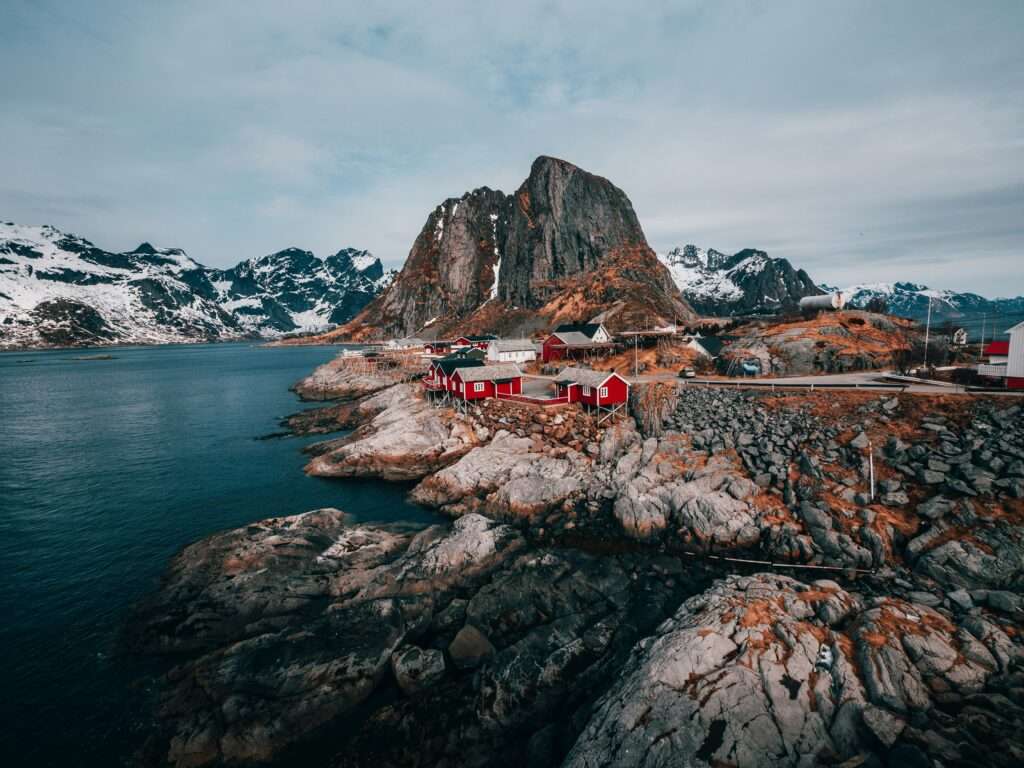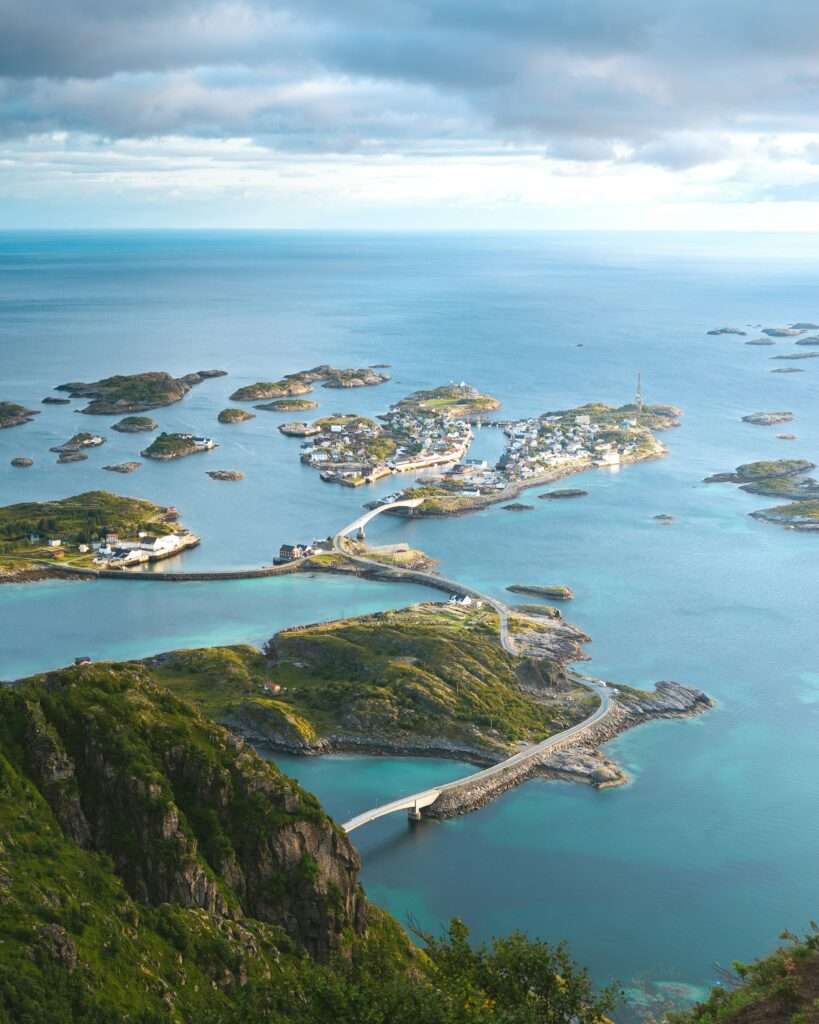Last Updated on 9 May 2025 by Johan
Moskenes municipality covers the southern part of Moskenes Island, where the landscape has been sculpted by glaciers and other elemental forces that have turned it into one of the wildest and most fascinating spots in Norway. Moskenes muncipality has approximately 1.200 inhabitants and covers a area of 118,6 km2, and lies in Nordland. Hermannsdalstind, altitude of 1.029 metres, the highest mountain in Western Lofoten. There are a large number of mountain lakes to fish in.
The landscape is characterised by sheer mountains and a narrow shoreline. There was settlement on the western side of the island, overlooking the mighty ocean, up until the 1950´s. Today, settlement is concentrated on the eastern side, where there are good harbour conditions for the fishing fleet, cargo vessels and pleasure boats. Services in the municipality are well-developed. Fisheries have been, and still are, essential for habitationin the municipality. In recent years, salmon farming and growing tourism have gained in importance. You will also find a sculpture in memory of Tennes-Kaspara, the last person to be beheaded in Moskenes.

In Moskenes, the fishing villages lie one after the other like pearls on a string. In places like Hamnøy, Sakrisøy, Reine, Sørvågen and Å, to name only a few of them, much can be learnt about everyday life in a fishing village. You can also follow the example of many travellers, and rent a fisherman´s hut, spending your vacation in an authentic and lively environment.
Moskenes has plenty to offer for those who wish to meet the elements. A boat trip by way of the Maelstrom, characterized as one of the fiercest – and possibly the most dangerous ocean currents in the world, brings us to the “Outside” of Lofoten. Here we find traces of settlement dating hundreds, indeed thousands of years back in time. Numerous other routes are recommended in Moskenes; both in the mountains and in any of the small fishing villages, so rich in tradition. A two hour hike from Sørvågen, along a signposted and marked rambler´s trail, will lead you to the Lofoten Tour Association´s mountain rambler´s cabin, “Munkebu” (DNT). From Reine a boat goes to one of Norway´s most beautiful fjords, Reinefjorden, where you can have a pleasant walk when you go ashore.
Wild mountains and fjords, idyllic islands and fishing villages, white sandy beaches and flowering fields, stormy seas and the midnight sun and Northern Lights.
STOCKFISH
Stockfish is unsalted fish, especially cod, dried by cold air and wind on wooden racks on the foreshore, called “hjell”. The drying of food is the world´s oldest known preservation method, and dried fish has a storage life of several years. The method is cheap and effective in suitable climates; the work can be done by the fisherman and family, and the resulting product is easily transported to market. A temperature just above zero degrees Celsius, with little rain, is ideal. Too much frost will spoil the fish, as ice destroys the fibers in the fish. The climate in northern Norway is excellent for stockfish production. Due to the stable conditions, the stockfish produced in Lofoten is regarded as the best. The traditional cod harvest in Lofoten also takes place during the best drying time.
MOSKENESØY
Far out in Kirkefjord on Moskenesøy are the tranquil fishing villages of Reine and Hamnøy in spectacular alpine surroundings. The landscape is wild with precipitous, polished mountains. Reine on Moskenesøy is one of the most beautiful places in Norway; and the island has some of the nation´s most rugged landscape.
On the soutcoast of Moskenesøy is the fishing village of Å. The last letter – in the Norwegian alphabet and the end of the Lofoten road. Å has a unique Fishing Museum, with many restored buildings, demonstrations and exhibits. There is lots of activity and many different experiences in summer. Ferry connections to Bodø, Værøy and Røst.
LOFOTODDEN
Norway´s largest coastal cave is on Lofotodden. The large crossformed cave, carved by the sea 100,000 years ago, has cave paintings dating back 3,000 years. It is only accessible by guided boats.
MOSKENESSTRAUMEN
The famous maelstrom Moskenestraumen rules the waters nearby (the strongest is Saltstraumen). The sea is turbulent even in the best weather. The maelstrom was described by the Greek historian Phyteas 2,000 years ago. Both Jules Verne and Edgar Allan Poe have used it as a setting for dramatic stories.
REINE
Reine is a fishing village and the administrative centre of the municipality of Moskenes. Reine Church is located here and it serves the northern part of the municipality. Reine has been a commercial centre since 1743. Today tourism is important, and despite of its remote location, thousands of people visit this village annually. The village is situated on a promontory just off the European route E10 highway, which passes through the village. Reine is located immediately to the south of Sakrisøy and Hamnøy. Reinebringen mountain is 448 meters high, far from one of the highest peaks on the Lofoten islands.

In 2016 construction on a stone stairway on the mountain was started due to the increased erosion and danger of rockfall from the high amount of visitation. The Nepali Sherpa team as completed all but the final 50 meters at the top of the mountain. So now the route is little more than a 1560 step stone staircase. It is likely the steps will be completed when funding can be obtained.
Å
Å is located towards the southern end of the Lofoten archipelago. It is connected to the rest of the archipelago by the European route E10 highway. This part of the highway is also called King Olav´s Road. The frequently stolen road sign approaching the village of Å. Until the 1990s, Å was mainly a small fishing village specializing in stockfish, but since then tourism has taken over as the main economic activity. The town features the Lofoten Stockfish Museum and the Norwegian Fishing Village Museum as two big tourist attractions.
NORWEGIAN FISHIG VILLAGE MUSEUM
At the Norwegian Fishing Village Museum in Å, you can join in on the activities, and appreciate the environment of a genuine traditional village. The museum is comprised of 14 buildings, each of which has its own purpose in the ancient village: a boat house, a steam processing plant for cod-liver oil, a forge, bakery, fishermens huts etc. What all these buildings have in common, is that they belong there, and have not been brought to Å “to become a museum”. The bakery and the blacksmith’s are in operation throughout the summer. The museum also produces and sells its own cod-liver oil.
STOCK FISH MUSEUM
Visit the stockfish museum in Å, opened in the summer of 1993, and learn about the thousand-year old history of stockfish as a trade commodity. Learn how stockfish is classed, where it is exported, and what is required of a first-class product.
KOLLHELLAREN
The gigantic Kollhellaren Cave is a coastal cavern with approximately 3,000 year old cave paintings. Organised boat trips and fishing trips in the Maelstrom, together with visits to the cave in Refsvika, in the company of authorised guides.
WORLD WAR II
At the ferry in Moskenes there is a bust of Colonel Birger Eriksen who was commander of Oscarsborg Fort on April 9, 1940. Oscarsborg Fort and Colonel Birger Eriksen is known for the sinking of the German warship “Blücher” on the 9th of April 1940, the day that Germany invaded Norway during the Second World War. The action allowed the King and government enough time to flee Oslo so that they could lead Norway’s effort in the struggle for liberation from abroad. Eriksen was born and raised in Moskenes.
GALLERY KRYSSET
Galleri Krysset, a private art gallery, can also be found in Sørvågen.
MUSEUM OF DOLLS and TOYS
On the island of Sakrisøya, Dagmar´s Museum of Dolls and Toys can be found – a place for the whole family. The first of its kind in Norway – opened in 1992.
HISTORIC EVENTS
1906: The world´s second wireless telegraph station was opened in Sørvågen. A permanent exhibition of the history of local telecommunications has been established in Sørvågen.
1928: North Europe´s first radio telephony project is started in Sørvågen. With the aim of linking broadcasting and telephone technology, church services in Moskenes Church were transferred to the radio station on 12 February 1929.
1941: The Reine Raid is carried out by Norwegian and British commandos.
1963: King Olav opens the Lofoten Road. The King goes ashore on Å and lays down a commemorative plaque at Hamnøy.
1992: “King Olav´s Road”, Highway E10 from Å to the national border.
MOUNTAINEERING
Lofoten´s mountains are a paradise for climbers. Popular climbs include The Raftsund range, Svolværgoat, Vågakallen and the mountains at Reine.
FISHING
The name Lofoten is often connected with the richest cod-fishing in the world. There is some farming, but fishing dominates as it has for hundreds of years. Lofoten´s cod fishing season is between January and April. The original method was lines pulled in by hand from open boats, but today´s modern fishing fleet employs more efficient fishing gear. There are a large number of mountain lakes to fish in. Fishing possibilities are good in Reinefjorden.
GOLF
Golfclubs in Nordland.